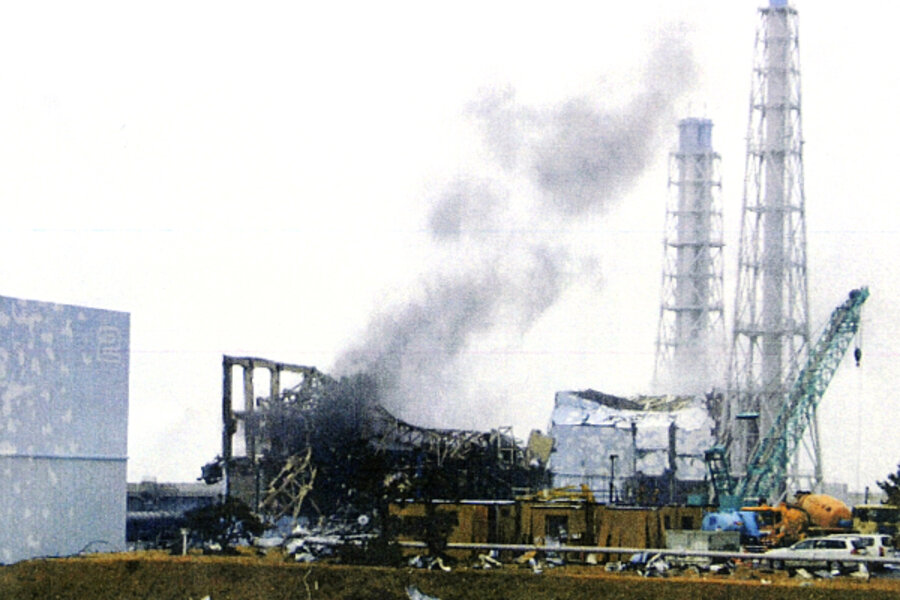Workers evacuated from Japan nuclear plant, again
Loading...
| Shingu, Japan
Workers were temporarily evacuated from the Fukushima Daiichi nuclear power plant in northern Japan today as gray smoke billowed from the plant late Monday afternoon.
The smoke was seen above building No. 3 just before 4 p.m., plant operator TEPCO said.That unit houses a spent fuel storage pool that was thought to have been nearly dry late last week, and has been the focus of an intense round the clock water-spraying operation over the weekend in an effort to cool it.
Today workers alternated between injecting water into the equally volatile No. 4 spent fuel pool and working to restore electricity to the plant’s normal cooling system.
Before the evacuation this evening, workers had made progress to stabilize the overheated reactors and fuel storage pools at the plant over the weekend. In the afternoon Prime Minister Naoto Kan issued a cautiously encouraging statement regarding their progress.
"We haven’t yet escaped danger, but we’re starting to see a ray of hope that we’ll be able to escape,” he said.
Where is the electricity?
The March 11 earthquake and tsunami knocked out electricity supplies that power cooling and control systems at all six units at Fukushima. Authorities reported that workers were close to connecting power supplies to the six units late last week to restore cooling and control systems.
Still, there appears to be some confusion about which units have electricity. Though some reports say that electric cables have been connected to all six units, and some indicate that electricity has been restored to four units, at 7p.m. the power company told the Monitor that cables have only been connected only to the reactors in buildings No. 1 and No. 2, though they said they were expected to reach units No. 3 and No. 4 soon.
Power company TEPCO said it still needed to inspect pumps, motors, and other machinery before it could restart the system. The company did not say how long that process would take. The government watchdog Nuclear and Industrial Safety Agency said today that a short had been detected in the motor used to supply water to the No. 2 reactor and storage pool.
Meanwhile, radiation measurements near the plant fell slightly from Sunday, but remained high.
TEPCO said the situation in building No. 5 and No. 6 had stabilized, with power from a backup diesel generator now flowing to both the reactors and spent fuel storage pools. Temperatures in the pools are down to about 40 degrees, they said.
Japan nuclear crisis: A timeline of key events
A seventh storage pool at Fukushima
Sixty percent of the used fuel at the Fukushima plant is stored in a seventh shared storage pool located in a separate building, according to the Nuclear Energy Institute, a Washington-based policy organization for the nuclear industry.
Electricity has not yet been restored to that pool, and the temperature there is increasing “very gradually,” said TEPCO’s Kenji Tateiwa.
"We’ve confirmed that there is enough water and that the temperature is in a safe range,” says Mr. Tateiwa. However, he was not able to provide exact figures for the temperature or water level.
Contamination concerns
In Fukushima and other parts of Japan, concern remains over vegetables, milk, and water contaminated by radiation leaking from the facility.
Yesterday the government announced that four prefectures had found vegetables contaminated with radioactive iodine and cesium. Contaminated milk was also found in Fukushima prefecture, and in Iitate Village, about 18 kilometers from the Fukushima plant, levels of iodine-131 measured in tap water were three times higher than what government regulations allow.
A representative of the Ministry of Health, Labor, and Welfare said the government had received no further reports of drinking water with radioactive elements exceeding the allowed limit. The government has advised residents of Iitate not to drink tap water, but maintains that none of the contaminated food or milk poses an immediate health threat.
Local governments throughout Japan continue to test farm products, water, and air for dangerous levels of radiation. The science ministry began posting the results online on Saturday in four languages, including English.





